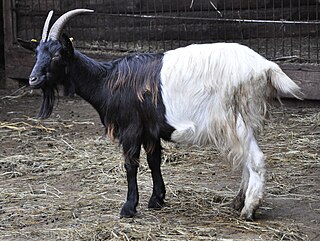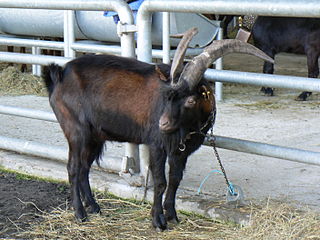The Corteno or Pecora di Corteno is a breed of sheep from the Val Camonica, in the province of Brescia in Lombardy, northern Italy. It is raised in the comune of Corteno Golgi, from which it takes its name, and in the neighbouring comuni of Edolo, Malonno and Paisco Loveno, all lying within the Comunità Montana di Valle Camonica. It is one of the forty-two autochthonous local sheep breeds of limited distribution for which a herdbook is kept by the Associazione Nazionale della Pastorizia, the Italian national association of sheep-breeders.

The Bionda dell'Adamello is an indigenous breed of domestic goat from the Val Camonica in the province of Brescia, in Lombardy in northern Italy. It takes its name from the massif of the Adamello, part of the Adamello-Presanella subsection of the Rhaetian Alps. It is raised mainly in the Val Camonica, the Val Saviore and the mountains of Brescia; some are found in neighbouring areas of the provinces of Bergamo to the west and Trento to the east. It was in the past known simply as the Capra Bionda or as the Mustàscia.

The Valais Blackneck is a breed of domestic goat from the canton of Valais, in southern Switzerland, and neighbouring areas of northern Italy. The largest concentration is in the area of Visp (Viège). It is present in modest numbers in Austria and Germany. It is known by many names, including German: Walliser Schwarzhalsziege or Gletschergeiss; French: Col Noir du Valais, Chèvre des Glaciers or Race de Viège; and Italian: Vallesana or Vallese.

The Orobica or Valgerola is a breed of domestic goat from the Val Gerola in the province of Sondrio, in the Bergamo Alps of northern Italy. It is raised in the Val Gerola and the Valchiavenna in the province of Sondrio, in the Alto Lario Occidentale, the Valsassina and the Val Varrone in the province of Como, and in the upper Val Brembana in the Province of Bergamo. The origins of the breed are unknown; it is first documented at the beginning of the twentieth century. The Orobica is one of the eight autochthonous Italian goat breeds for which a genealogical herdbook is kept by the Associazione Nazionale della Pastorizia, the Italian national association of sheep-breeders.
The Frabosana is a breed of sheep from the valleys of the Monregalese, the area around Mondovì in the province of Cuneo, in Piemonte in north-west Italy. It takes its name from the comuni of Frabosa Soprana and Frabosa Sottana, and was once the most numerous sheep breed of Piemonte. It is raised in the Valle Gesso, the Valle Grana, the Valle Pesio, the Valle Vermenagna and the Valli Monregalesi in the province of Cuneo, and in the Val Pellice in the province of Turin. Two types are recognised within the breed, the Roaschino in the Ligurian Alps, and the slightly smaller Frabosana raised in the area of Mondovì. The Frabosana is one of the forty-two autochthonous local sheep breeds of limited distribution for which a herdbook is kept by the Associazione Nazionale della Pastorizia, the Italian national association of sheep-breeders.
The Garessina or Muma is a breed of small sheep from the Garessina, the area surrounding Garessio in the province of Cuneo, in Piemonte in north-west Italy. It is raised principally in the valleys of the Tanaro, its affluent the Negrone, and the Casotto; it is not raised commercially, but kept as a family sheep. It has been influenced by Spanish Merino and French Alpine breeds. The wool is of fine quality. The Garessina is one of the forty-two autochthonous local sheep breeds of limited distribution for which a herdbook is kept by the Associazione Nazionale della Pastorizia, the Italian national association of sheep-breeders.
The Pomarancina is a breed of domestic sheep from Tuscany in central Italy. It is raised mainly in the comune of Pomarance, from which it takes its name, and in the neighbouring comuni of Castelnuovo di Val di Cecina, Montecatini Val di Cecina and Volterra, all in the province of Pisa; some are kept in other parts of Tuscany, in the provinces of Grosseto, Livorno, Lucca and Siena. It is one of the forty-two autochthonous local sheep breeds of limited distribution for which a herdbook is kept by the Associazione Nazionale della Pastorizia, the Italian national association of sheep-breeders.

The Rosset is a breed of domestic sheep from the Valle d'Aosta in north-west Italy. It is morphologically similar to the Savoiarda breed from Piemonte and to the Thônes et Marthod breed from Savoie; it may have been influenced also by the Blanc des Alpes and the Biellese. It is one of the forty-two autochthonous local sheep breeds of limited distribution for which a herdbook is kept by the Associazione Nazionale della Pastorizia, the Italian national association of sheep-breeders.
The Sempione is a rare breed of domestic goat from the mountains of Piemonte in north-western Italy and the neighbouring area of Simplon in the canton of Valais in Switzerland; Sempione is the Italian name for Simplon. The Sempione goat is well documented in photographs from the early twentieth century, but is now thought to be close to extinction, and has more than once been considered extinct. Examples were recorded at Saliceto di Cravagliana in the province of Vercelli in 1983, and others have since been identified in the province of Verbano-Cusio-Ossola, particularly in the Val Divedro and the upper Ossola.
The Passeirer Gebirgsziege or Capra Passiria is an indigenous breed of domestic goat from the Passeier valley or Val Passiria, in the Autonomous Province of Bolzano in north-eastern Italy. It is raised in that valley and in the neighbouring Sarntal, Schnalstal and upper Wipptal valleys; it is also present in neighbouring areas of southern Austria. While of Alpine type, it is morphologically quite distinct from the Alpina Comune goat breed. Management is extensive: the animals are kept on alpine pasture from early spring to late autumn.
The Napoletana is a breed of domestic goat from the area south of Naples, in Campania in southern Italy. It is raised on the slopes of Vesuvius, on the slopes of the Monti Lattari, and in the Agro Nocerino Sarnese which lies between them. The origin of the breed is unknown. It may derive from goats of African origin imported to the area in the early years of the twentieth century; the alternative name Torca Nera, "black Turkish goat", suggests an origin in the Mediterranean basin.
The Lariana or Capra di Livo is an indigenous breed of domestic goat from the province of Como, in Lombardy in northern Italy. It is raised in the Livo valley and throughout the western Lario; the two names of the breed derive from these places. It is of Alpine type and has highly variable characteristics. Management is extensive: the animals are kept on alpine pasture from May to December, and brought under cover for the winter months.
The Di Teramo is an indigenous breed of domestic goat from the province of Teramo, in Abruzzo in southern Italy, and is raised only in that area. Numbers are very low; the breed was listed as endangered by the FAO in 2007. It is further threatened by cross-breeding with the Garganica breed.
The Cilentana Fulva is an indigenous breed of domestic goat from the province of Salerno, in Campania in southern Italy. It takes its name from the geographical region of the Cilento, much of which is today within the Parco Nazionale del Cilento, Vallo di Diano e Alburni, and is raised in that area, in the Monti Picentini, and throughout the province of Salerno. It is one of three indigenous goat breeds in the Cilento, the others being the Cilentana Grigia and the Cilentana Nera. The Cilentana Fulva is found on lower ground and richer pasture than the Cilentana Nera, and is raised mainly for milk. It appears to derive from inter-breeding of local goats with the Maltese and particularly the Derivata di Siria, with which it shares many characteristics.

The Nera Verzasca, also known as the Nera di Verzasca or Verzaschese, is an indigenous breed of black domestic goat from the Valle Verzasca, in the canton of Ticino in southern Switzerland, from which it takes its name. It is raised in that area and in the provinces of Como, Varese and Verbano Cusio Ossola in northern Lombardy, in the north of Italy.
The Valfortorina or Capra di Benevento is a rare breed of domestic goat from the Val Fortore in the province of Benevento, in Campania in southern Italy. It survives in very low numbers, and its conservation status was listed as "critical" by the FAO in 2007. A small number are kept at Benevento by the Consorzio per la Sperimentazione, Divulgazione e Applicazione di Biotecniche Innovative (ConsDABI), the institution responsible for the conservation of genetic resources in Italy.
The Roccaverano is an indigenous breed of large domestic goat from the Langhe, in the provinces of Asti and Cuneo, in Piemonte in north-western Italy. It is raised mainly in the Langa Astigiana, mostly within the Comunità montana Langa Astigiana Val Bormida, and is named for the town and comune of Roccaverano in that area. The origins of the breed are unknown.

The Chamois Coloured Goat, French: Chèvre chamoisée, German: Gämsfarbige Gebirgsziege, Italian: Camosciata delle Alpi, is an indigenous breed of domestic goat from Switzerland. It is distributed throughout Switzerland and in parts of northern Italy and Austria, and has been exported to other countries including France. There are two strains, a horned type from the Grisons or Graubünden in the eastern part of the country, and a hornless type from the former bezirk of Oberhasli and the area of Brienz and Lake Brienz in the Bernese Oberland in central Switzerland. In some countries the hornless variety may be considered a separate breed, the Oberhasli goat. The Swiss herd-book was established in 1930.

The Frisa Valtellinese is an indigenous breed of domestic goat from the province of Sondrio, in Lombardy in northern Italy. It is raised throughout the Valtellina, from which its principal name derives, in the Val Malenco and the upper Val Masino in the Rhaetian Alps, and in the Valchiavenna. It may also be called the Frontalasca, for the village of Frontale, a frazione of the comune of Sondalo in the Val di Rezzalo, or the Rezzalasca for that valley. The name Frisa comes from its frisature, or Swiss markings.

The Alpina Comune is a heterogeneous population of domestic goats widely distributed in the Alps of northern Italy, particularly in the regions of Lombardy and Piemonte. It is highly variable in size, in morphological characteristics such as the type, colour and pattern of its coat and the shape and carriage of its ears, and in type of use. It does not display any of the uniformity characteristic of a breed, other than a consistent hardiness and adaptation to mountain terrain. It is however officially recognised and protected as one. The name Alpina Comune, "common", is more used in Piemonte; in Lombardy it may be called Alpina Locale, "local", or simply Nostrana, "ours".









